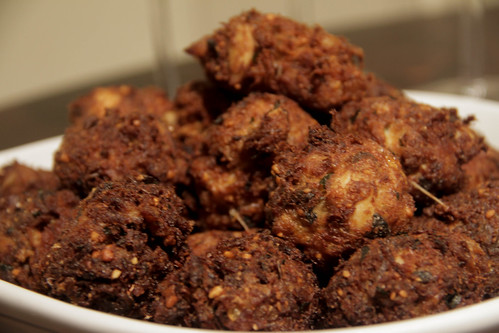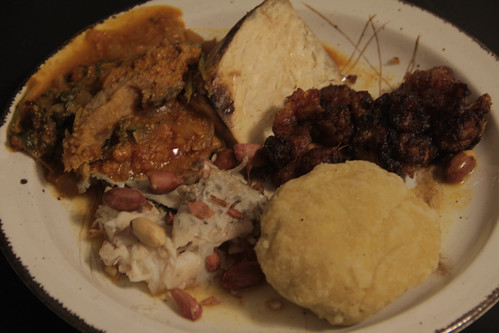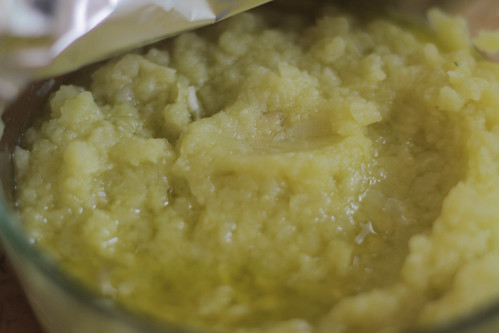If you know anything about Guinea-Bissau, chances are it's the dubious media-granted title of "the world's first narco-state" and the ensuing coup. Conveniently located just a few days' boating from South America, the small former Portuguese colony has become a waystation for drugs en route to Europe. The army not only consents but participates, increasingly so since last year's coup. Not surprisingly, the money hasn't reached the people; Guinea-Bissau is among the least-developed countries in the world. While the country is poor, it does offer some rich culinary opportunities. Not surprisingly, given its coastal location, much of the dishes are fish and seafood based. Due to scheduling confusion and illness, half our guests couldn't make it, so we had an intimate crowd of Karen, Ryan, and Sarah-Doe.
Cashew rum
Did you know that the cashew is actually the seed of a fruit? It's known as the cashew apple, and looks like this:

The Portuguese found cashews in Brazil, and as far as I can tell, wherever the Portuguese colonized, they brought cashews with them. In fact, the economy of Guinea-Bissau has become so dependent on cashew farming that a recent price dip has been wreaking havoc on an already fragile economy.

While cashews are a cash crop traded around the world, the fruit -- which is tasty and tangy and packed with vitamins -- bruises easily and doesn't transport well. But one thing that could transport, but for some reason we don't see in temperate climes, is cashew rum, the brandy made from fermenting and distilling the fruit. We found some in Goa on our trip to India in January, they call it feni there, and it has a distinctive and almost cloying tropical-fruit aroma. We brought some back, and had no clue what we'd do with it, until I read in a travel guide that cashew rum is popular in Guinea-Bissau. So I whipped up some hibiscus drink, poured in some rum, and it was a great combo, the tartness really cut through the strength of the rum to just be all around satisfying.
Bolinhos de mancarra com peixe | Fish and peanut balls | Recipe at end of post

A large portion of the recipes I found were for fried fish balls, so for the first time in months I pulled out the deep fryer. Oh boy, was it worth it. The unlikely combination of fishiness and nuttiness works so well. And the texture was an extra bonus: a dense and moist inside with a crisp outside, and just enough grease to make you want to take a sip of your drink and eat another! As you'll see from the recipe below, it's a fair amount of work, but I don't regret it a bit.
Pitche-patche de ostras | Oyster stew | Recipe

Oysters in Africa? Apparently so! If you happen to have a bunch of oysters laying around, and you don't feel like eating them raw, it's hard to think of a simpler way to prepare them in a tasty way. This is, naturally, a pretty soft and filling food: pale, mushy oyster and plump, white rice in a clear broth. But the chili and smattering of veggies give it just enough color and bite to make for a surprisingly satisfying soup.
Frango com bagique | Chicken with spinach | Recipe

A pretty simple dish, essentially chicken gently simmered in red palm oil with greens. (I did quite a bunch of sleuthing which led me to come to the not-firm conclusion that bagique is sorrel leaves, but since I couldn't find any sorrel, I just followed the recipe and went with spinach.) I marinated the chicken in the oil and onion mixture for a while, maybe it helped a bit. If you don't want to do all that pounding you could save yourself some effort and grind it in a food processor. The cooking time is an underestimate, I probably needed an extra 20 minutes, which you could probably cut out if you put a lid on the pot. A decent dish, and a fine introduction to African cooking that requires only one specialty ingredient.
Mandioca assada com xarope de cana | Grilled cassava with cane syrup | Recipe

When life gives you sugar cane and a bland, mealy root vegetable, I guess you should heat up the former and roast the latter and mix them. I dunno, this didn't do it for me, baked is so flavorless that even with the syrup on top I kinda felt like I was eating a whole lot of nothing.
~~~
As promised, here's the recipe for the deep-fried goodness!
Bolinhos de mancarra com peixe
Fish and peanut balls
Recipe adapted from Cuisines of Portuguese Encounters by Cherie Hamilton
1 cup shelled roasted peanuts (or a few cups in the shell) 2.5 pounds mackerel fillets (for me, that was three medium-small fish) Juice of 1 lemon 1 teaspoon salt 1/4 teaspoon pepper 1/2 onion, sliced thin 1 tablespoon vegetable oil 2 medium onions, grated A few sprigs parsley, chopped 1 teaspoon salt 1 egg Vegetable oil for frying
Grind peanuts in a food processor and set aside. Stop a bit short of making peanut butter.
Mix lemon juice, salt, pepper, and onion in a wide dish, add the fillets, flip the fillets to coat them, and let marinate for at least 30 minutes. Heat the tablespoon of oil in a skillet or frying pan (a non-stick one would be convenient), and fry the fillets until brown on both sides; discard the marinade. Don't despair if the fillets break up. Remove the fillets to a paper-towel-lined plate; once they're cool enough to handle, flake the fish into a bowl. Start heating up your frying oil; I went for about 350 degrees in a deep fryer. (Note: this is a great article about deep frying, it focuses on how many times you can re-use oil but contains many great tips.)
Add onions, parsley, salt, and the egg to the bowl, along with the peanuts you've ground. Mix everything together with your hands. Form into ping-pong size balls, paying a bit of care to pack the mass and smooth the edges. You should get about 30. In my small home fryer I cooked four or five at a time, jostling halfway through to ensure even browning. (If the balls break up partway through, do something to help the balls stay together more: maybe another egg, or cornstarch. All is not lost, you can take the broken fried bits and re-combine them in with the rest of the mixture to start afresh and extra-crispy.) Remove to a paper towel. It's your choice whether to serve hot or cold; it's obligatory to serve with a drink!



 At least in Guinea, fonio is eaten like couscous. It's a bit labor-intensive to cook; even the "pre-cooked" version first is plumped up with boiling water, steamed twice in cheesecloth, blended with a bit of okra powder to make it malleable (when you're eating with your hands it sure helps if it sticks together), and steamed once more. The texture was like couscous with a little more tooth, and it had a nice and mild nuttiness. If you happen to see fonio somewhere, give it a shot, before everyone discovers it in like ten years.
At least in Guinea, fonio is eaten like couscous. It's a bit labor-intensive to cook; even the "pre-cooked" version first is plumped up with boiling water, steamed twice in cheesecloth, blended with a bit of okra powder to make it malleable (when you're eating with your hands it sure helps if it sticks together), and steamed once more. The texture was like couscous with a little more tooth, and it had a nice and mild nuttiness. If you happen to see fonio somewhere, give it a shot, before everyone discovers it in like ten years.
 When I asked for fermented cornflour at Owa Afrikan Market, the kindly shopkeeper replied, "Kenkey? Oh, that's from Ghana. We're a Nigerian store!" I didn't have much better luck at Diaby African Market, which is run by shopkeepers from Cote d'Ivoire who are equally friendly but equally devoid of kenkey. Just as I'd begun to grow a bit fatigued of what seem to be a limited range of very common African staples -- smoked fish, palm oil, cassava, yam, plantain, peanuts -- I was so happy to discover first-hand some real regional variation that I quickly overcame the disappointment of not finding what I was looking for. (Plus, as you'll see below, I got creative and found my way around it.)
When I asked for fermented cornflour at Owa Afrikan Market, the kindly shopkeeper replied, "Kenkey? Oh, that's from Ghana. We're a Nigerian store!" I didn't have much better luck at Diaby African Market, which is run by shopkeepers from Cote d'Ivoire who are equally friendly but equally devoid of kenkey. Just as I'd begun to grow a bit fatigued of what seem to be a limited range of very common African staples -- smoked fish, palm oil, cassava, yam, plantain, peanuts -- I was so happy to discover first-hand some real regional variation that I quickly overcame the disappointment of not finding what I was looking for. (Plus, as you'll see below, I got creative and found my way around it.)
































